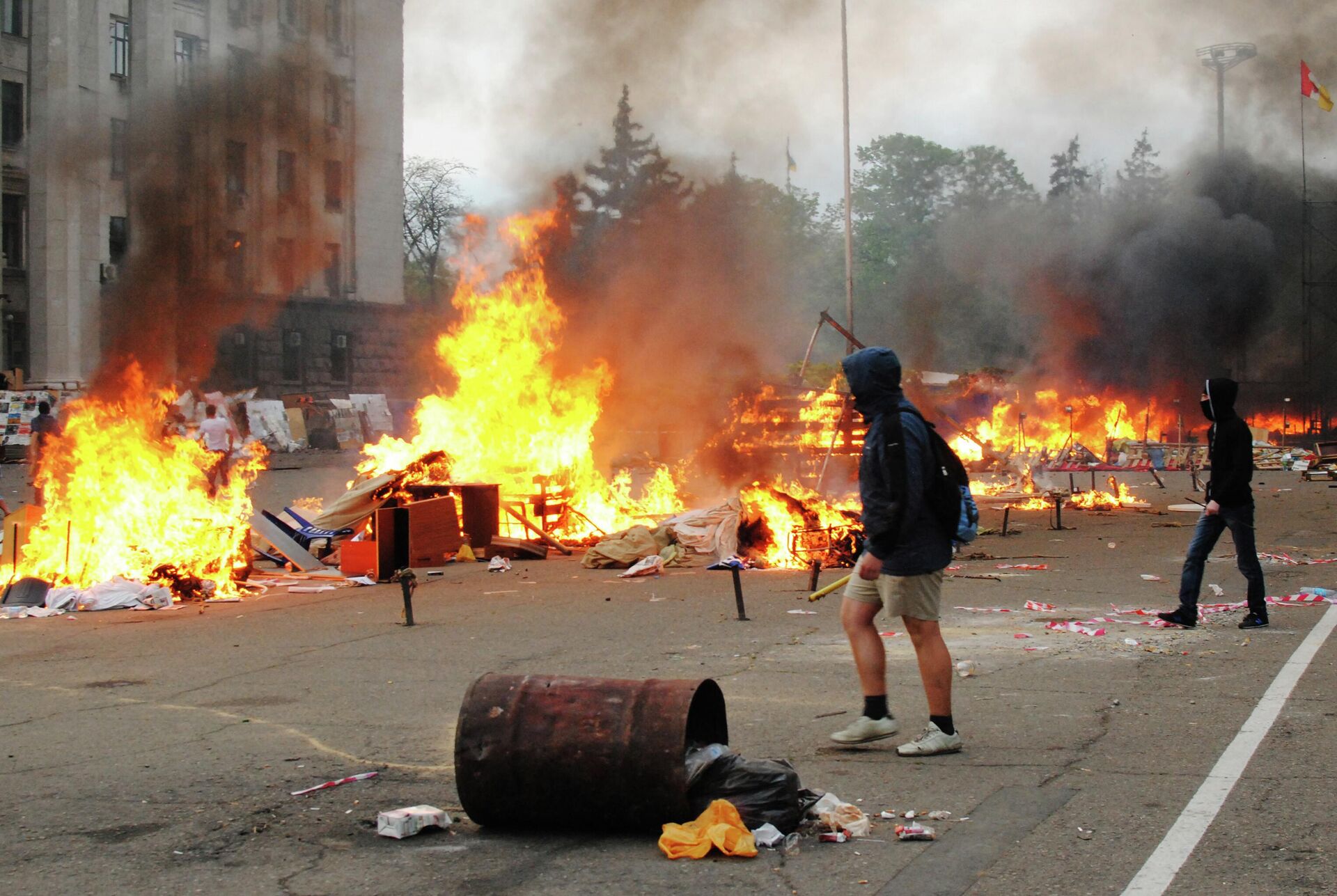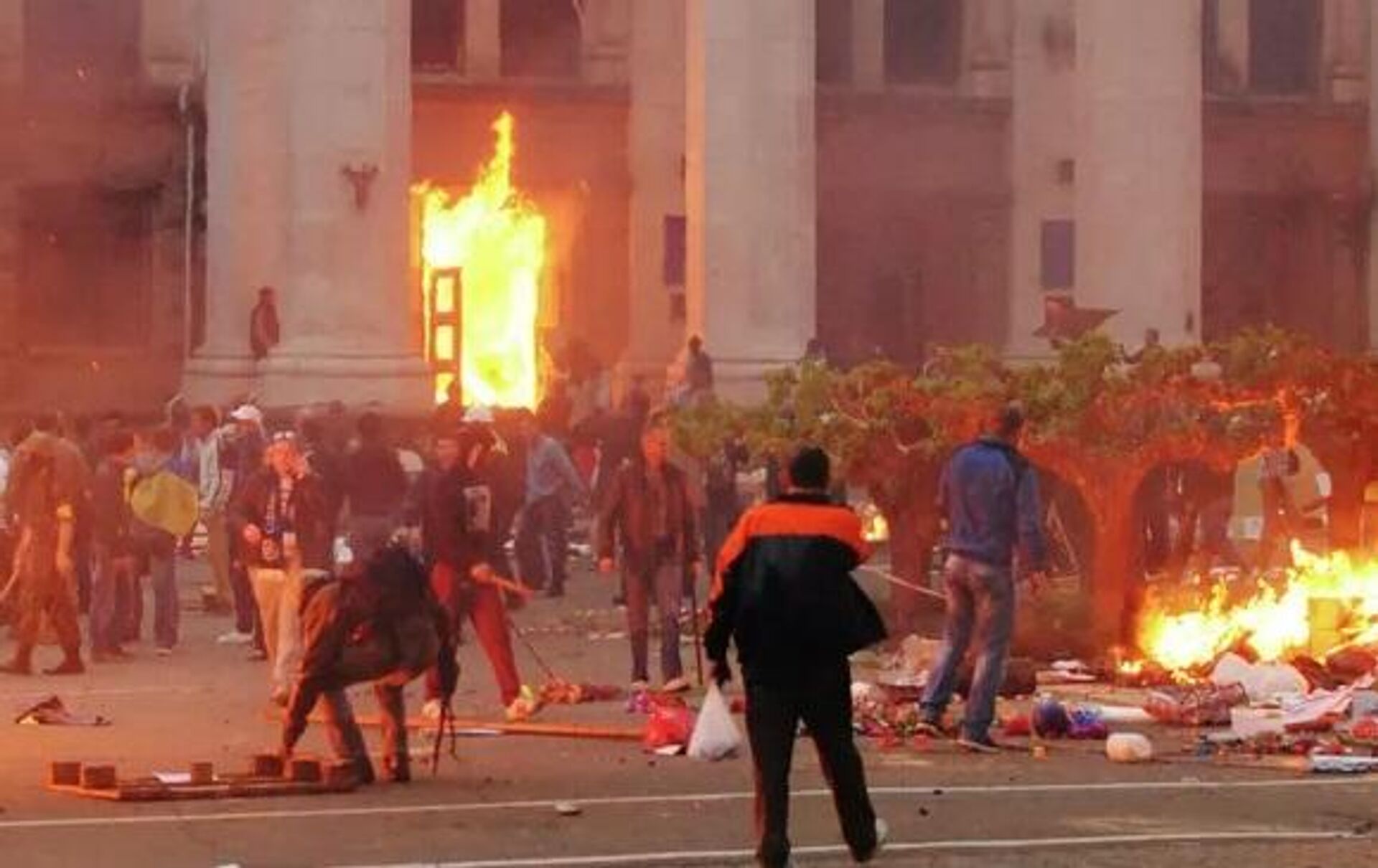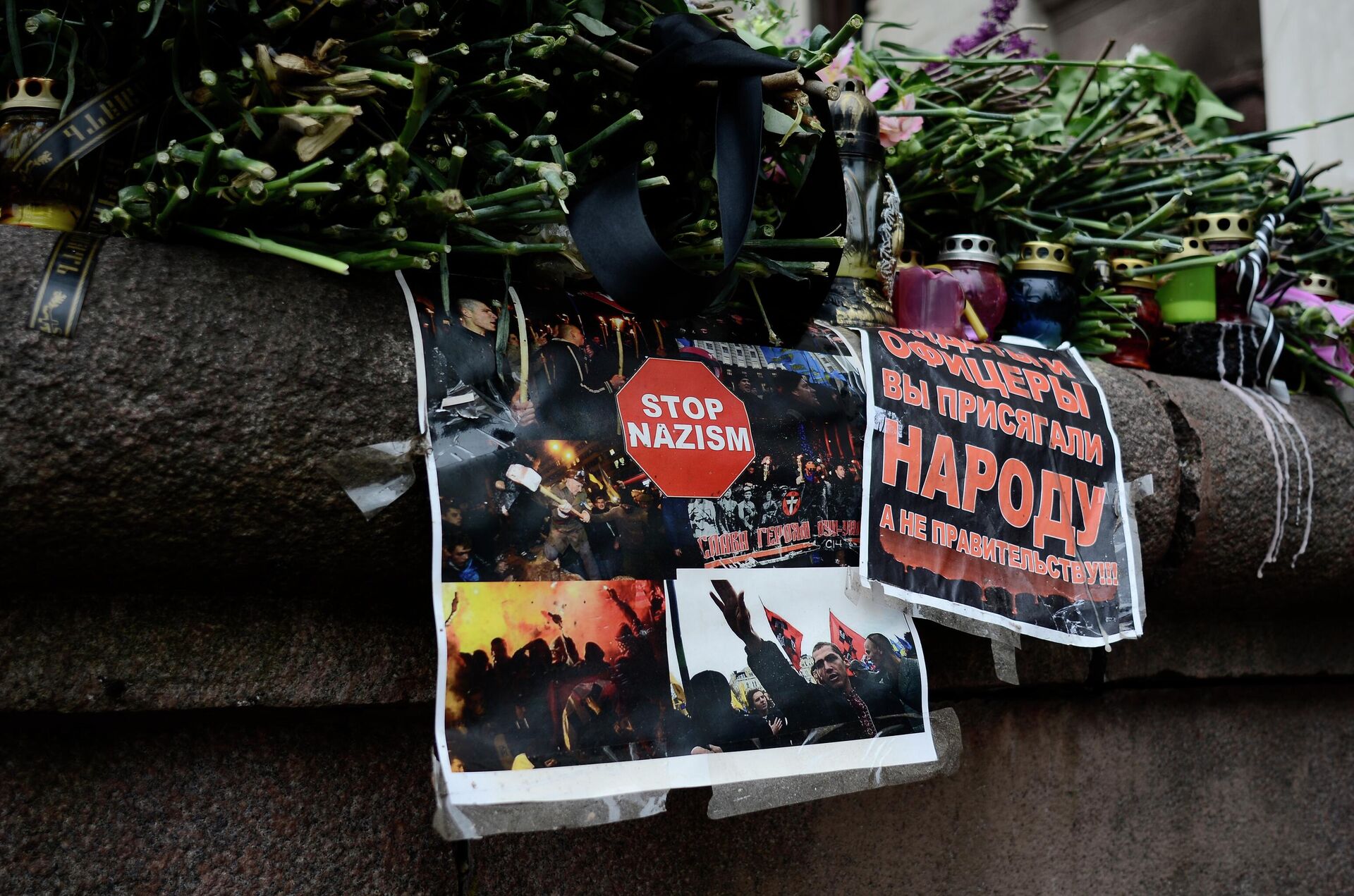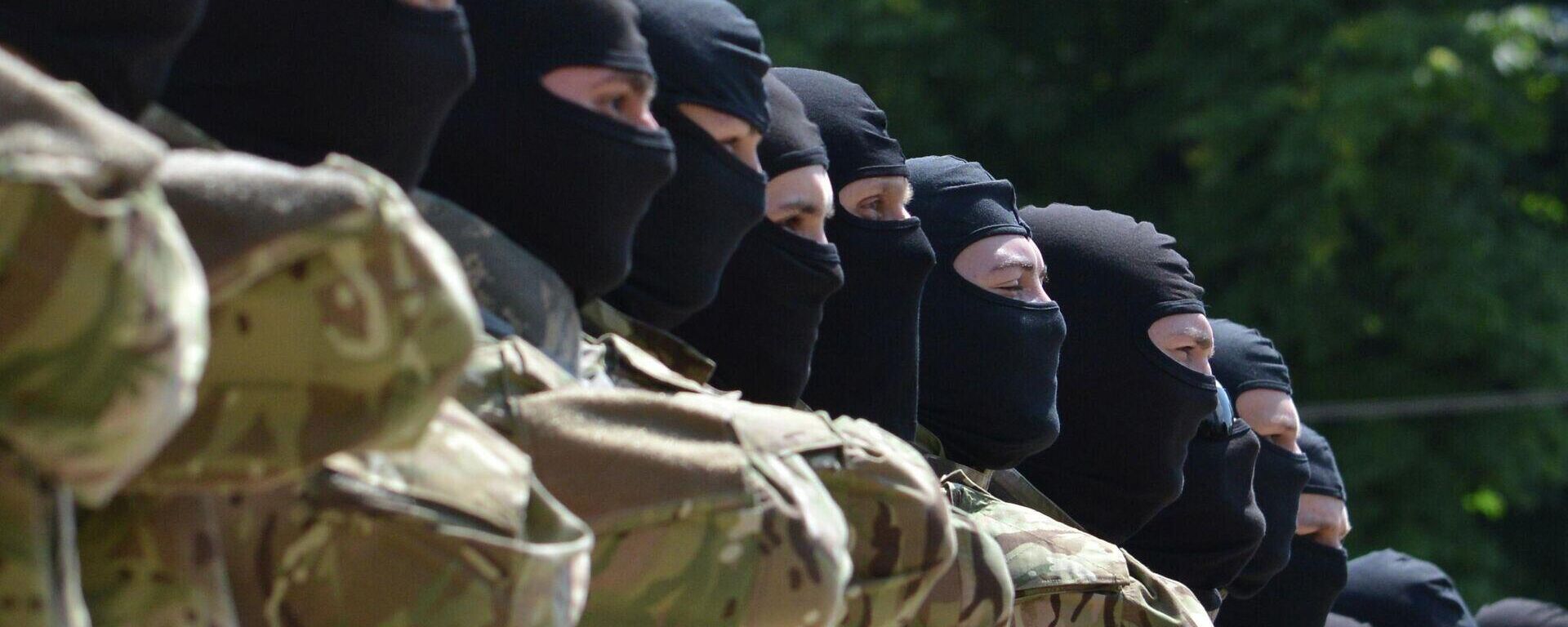https://sputnikglobe.com/20230502/journo-i-can-be-jailed-for-treason-in-ukraine-for-telling-truth-about-2014-odessa-massacre-1109983490.html
Journo: I Can be Jailed for Treason in Ukraine for Telling Truth About 2014 Odessa Massacre
Journo: I Can be Jailed for Treason in Ukraine for Telling Truth About 2014 Odessa Massacre
Sputnik International
May 2 marks the ninth anniversary of the 2014 Odessa Trade Unions House massacre. An Odessa journalist who witnessed the tragedy shared his memories of the day that saw roughly 50 people bludgeoned to death or burned alive with Sputnik.
2023-05-02T07:00+0000
2023-05-02T07:00+0000
2024-02-25T13:44+0000
world
russia
ukraine
viktor yanukovych
andriy parubiy
odessa
european union (eu)
neo-nazis
neo-nazism
massacre
https://cdn1.img.sputnikglobe.com/img/07e6/02/19/1093375778_0:203:2044:1353_1920x0_80_0_0_60d6f6da3c9285e0d91cccbd29d04cc8.jpg
"I was part of a film crew; I was in the center of the city. When we arrived, everything was already on fire," said the journalist, who asked Sputnik to disguise his identity and use an alias, Alexander Kataev, for security reasons."A woman threw herself on the hood of our car and cried: 'Help, people are burning there'. It was hard to wrap your mind around the fact that people were dying there. One couldn't realize that right away. At the same time, around 30 policemen were standing on the sidelines and calmly smoking just about 50 meters from the burning building, along the road, behind the bushes. At that moment, as it turned out later, people were jumping out of the building on fire. After that, they were finished off on the ground. Still, policemen just stood and smoked and not a single fire truck was around at the moment."The victims were mostly the members of a Kulikovo Pole movement which was launched by those who didn't accept the ousting of Ukrainian President Viktor Yanukovich in February 2014. The protesters set up a protest camp at Kulikovo Pole Square, a large garden square located in a historic center of the city. It became a symbol of resistance for all those dissatisfied with the US-backed coup d'etat in Ukraine.How It All BeganFollowing months of mass riots in Kiev, Ukrainian President Viktor Yanukovych and opposition leaders signed an agreement "On the settlement of the political crisis in Ukraine" mediated by representatives of the European Union and Russia on February 21, 2014. Nonetheless, the very next day, all agreements were unilaterally torn apart by violent protestors who seized government buildings by force and established full control of the Ukrainian capital.The US mainstream media reported at the time that Ukraine's ultra-nationalist parties and their paramilitary groups played a key role in the 2014 regime change in Kiev and later assumed positions in the National Security and Defense Council, the Office of the Prosecutor General, and the Ministries of Ecology and Agriculture of the interim government."Far-right, anti-Semitic, anti-Russian, and openly fascist groups have existed and do exist as a blight on modern Ukraine," CNN wrote in March 2014.The Kiev junta pursued an openly Russophobic agenda, cracking down on dissenters and silencing the opposition. Many regions of eastern Ukraine did not accept the Maidan coup and launched protest movements. The Crimean peninsula held a referendum to gain autonomy and re-join Russia in March 2014. Pro-Russian marches took place in Donbass. Tens of thousands took to the streets in Odessa.In comparison to this manifestation of the people's will, tens or even hundreds of Maidan supporters gathering near the monument to the Duke de Richelieu in Odessa looked pathetic. "Nobody took them seriously. They were seen as insane people whose fellows ran around the Maidan a couple of months ago with pots on their heads," Kataev said.May 2 in Odessa Changed EverythingNothing hinted at any impending trouble on May 2, 2014, in Odessa. And still the unfolding situation was nothing short of surrealistic, the journalist recalled. It was a holiday, most of the people in Odessa were still celebrating May Day (International Workers Day) with some going on day trips out of the city, while others stayed home. What could go wrong?Suddenly, it turned out that street violence had been gaining momentum across the city. Clashes were going on here and there, armed people were spotted in the crowds, and people opened fire.The crux of the matter was that the police allowed another 800 Ukrainian nationalists and neo-Nazis from Kharkov and Dnepropetrovsk into Odessa. Checkpoints close by were controlled by pro-Maidan militias supervised by Andriy Parubiy, a Maidan commandant and nationalist politician who was appointed as the secretary of Ukraine’s National Security and Defense Council.In addition, on that day, a Ukrainian football championship game between FC Chernomorets Odessa and FC Metalist Kharkov was to take place at 5 pm in Odessa. Ukrainian football fans and pro-Maidan activists – equipped with guns and Molotov cocktails – attacked pro-Russian protestors driving them towards Kulikovo Pole Square. Violent clashes passed to the tent camp in the square, making it dangerous to stay there. The Kulikovo Pole movement members needed shelter.It appeared to them that they would be safe in the Trade Unions House, a five-storybuilding located nearby, on Kulikovo Pole. Alas, the building became a trap for them.After a series of clashes in the first two stories of the building, pro-Russia protesters found themselves blocked. Meanwhile, Ukrainian nationalists set the Trade Unions House on fire, not allowing people to escape as flames and smoke engulfed the building. Those who jumped out of the windows either fell to their death or were bludgeoned by pro-Maidan activists.It was later reported that even though a police officer on duty informed the state emergency services of the need to urgently dispatch fire brigades to the site, his request was initially ignored. Firefighters arrived around an hour later; by that time the fire and the ongoing massacre had already claimed dozens of lives.No Justice, No PeaceThose who survived the massacre or were suspected of sympathy to Russia have been subjected to purges ever since that day.Ukrainian prosecutors typically used criminal charges to put pro-Russian activists behind bars, according to the journalist.Justice would never prevail under the Kiev regime, according to the journalist, who still does not lose hope."One should approach this issue from the point of view of collective responsibility. Because one brought the gasoline, the second one poured it into bottles, the third carried Molotov cocktails, and the fourth set fire to the building (…) In my opinion, everyone who was there on the square, everyone should be punished for mass murder, at least."
https://sputnikglobe.com/20220304/why-is-the-west-silent-about-ukrainian-neo-nazi-movements-azov-battalion--bandera-legacy-1093561142.html
https://sputnikglobe.com/20230403/targeting-the-unarmed-ukraines-grim-record-of-terrorist-attacks-1109074865.html
russia
ukraine
odessa
Sputnik International
feedback@sputniknews.com
+74956456601
MIA „Rossiya Segodnya“
2023
News
en_EN
Sputnik International
feedback@sputniknews.com
+74956456601
MIA „Rossiya Segodnya“
Sputnik International
feedback@sputniknews.com
+74956456601
MIA „Rossiya Segodnya“
ukraine 2014 coup d'etat, odessa 2014 clashes, odessa massacre, odessa fire trade union, odessa fire ukraine, odessa trade unions house massacre, odessa trade unions fire 2014, ukrainian nationalism, ukrainian neo-nazism, ukrainian pro-russia protests, odessa kulikovo pole movement
ukraine 2014 coup d'etat, odessa 2014 clashes, odessa massacre, odessa fire trade union, odessa fire ukraine, odessa trade unions house massacre, odessa trade unions fire 2014, ukrainian nationalism, ukrainian neo-nazism, ukrainian pro-russia protests, odessa kulikovo pole movement
Journo: I Can be Jailed for Treason in Ukraine for Telling Truth About 2014 Odessa Massacre
07:00 GMT 02.05.2023 (Updated: 13:44 GMT 25.02.2024) May 2 marks the ninth anniversary of the 2014 Odessa Trade Unions House massacre. An Odessa journalist who witnessed the tragedy shared his memories of the day that saw roughly 50 people bludgeoned to death or burned alive with Sputnik.
"I was part of a film crew; I was in the center of the city. When we arrived, everything was already on fire," said the journalist, who asked Sputnik to disguise his identity and use an alias, Alexander Kataev, for security reasons.
"A woman threw herself on the hood of our car and cried: 'Help, people are burning there'. It was hard to wrap your mind around the fact that people were dying there. One couldn't realize that right away. At the same time, around 30 policemen were standing on the sidelines and calmly smoking just about 50 meters from the burning building, along the road, behind the bushes. At that moment, as it turned out later, people were jumping out of the building on fire. After that, they were finished off on the ground. Still, policemen just stood and smoked and not a single fire truck was around at the moment."
The victims were mostly the members of a Kulikovo Pole movement which was launched by those who didn't accept the ousting of Ukrainian President Viktor Yanukovich in February 2014. The protesters set up a protest camp at Kulikovo Pole Square, a large garden square located in a historic center of the city. It became a symbol of resistance for all those
dissatisfied with the US-backed coup d'etat in Ukraine.
Following months of mass riots in Kiev, Ukrainian President Viktor Yanukovych and opposition leaders signed an agreement "On the settlement of the political crisis in Ukraine" mediated by representatives of the European Union and Russia on February 21, 2014. Nonetheless, the very next day, all agreements were unilaterally torn apart by violent protestors who seized government buildings by force and established full control of the Ukrainian capital.
The US mainstream media reported at the time that Ukraine's ultra-nationalist parties and their paramilitary groups played
a key role in the 2014 regime change in Kiev and later assumed positions in the National Security and Defense Council, the Office of the Prosecutor General, and the Ministries of Ecology and Agriculture of the interim government.
"Far-right, anti-Semitic, anti-Russian, and openly fascist groups have existed and do exist as a blight on modern Ukraine," CNN wrote in March 2014.
The Kiev junta pursued
an openly Russophobic agenda, cracking down on dissenters and silencing the opposition. Many regions of eastern Ukraine did not accept the Maidan coup and launched protest movements. The Crimean peninsula
held a referendum to gain autonomy and re-join Russia in March 2014. Pro-Russian marches took place in Donbass. Tens of thousands took to the streets in Odessa.
"Pro-Russian rallies brought together around 25,000 in Odessa," Kataev said. "I was there too, filmed everything, participated in these rallies with people carrying Russian flags and shouting 'Russia'. The last time, 25,000 people crossed the city from Kulikovo Pole to the coast. And this was not arranged by an administrative resource. By that time, there were no administrative resources. More precisely, the reins of the city were already in the hands of the Maidanites."
In comparison to this manifestation of the people's will, tens or even hundreds of Maidan supporters gathering near the monument to the Duke de Richelieu in Odessa looked pathetic. "Nobody took them seriously. They were seen as insane people whose fellows ran around the Maidan a couple of months ago with pots on their heads," Kataev said.
May 2 in Odessa Changed Everything
Nothing hinted at any impending trouble on May 2, 2014, in Odessa. And still the unfolding situation was nothing short of surrealistic, the journalist recalled. It was a holiday, most of the people in Odessa were still celebrating May Day (International Workers Day) with some going on day trips out of the city, while others stayed home. What could go wrong?
"We arrived at the center, and there, across the road, fighting was going on, stones and sticks were thrown, and screams were heard," he said. "At the same time, on the other side of the road in a street cafe, people were sitting, drinking coffee with ten of them filming this fight on their phones. There was no call: 'Arise, Great Country!'"
Suddenly, it turned out that street violence had been gaining momentum across the city. Clashes were going on here and there, armed people were spotted in the crowds, and people opened fire.
The crux of the matter was that the police allowed another 800 Ukrainian nationalists and neo-Nazis from Kharkov and Dnepropetrovsk into Odessa. Checkpoints close by were controlled by pro-Maidan militias
supervised by Andriy Parubiy, a Maidan commandant and nationalist politician who was appointed as the secretary of Ukraine’s National Security and Defense Council.
In addition, on that day, a Ukrainian football championship game between FC Chernomorets Odessa and FC Metalist Kharkov was to take place at 5 pm in Odessa. Ukrainian football fans and pro-Maidan activists – equipped with guns and Molotov cocktails –
attacked pro-Russian protestors driving them towards Kulikovo Pole Square. Violent clashes passed to the tent camp in the square, making it dangerous to stay there. The Kulikovo Pole movement members needed shelter.
It appeared to them that they would be safe in the Trade Unions House, a five-storybuilding located nearby, on Kulikovo Pole. Alas, the building became a trap for them.
After a series of clashes in the first two stories of the building, pro-Russia protesters found themselves blocked. Meanwhile, Ukrainian nationalists set the Trade Unions House on fire, not allowing people to escape as flames and smoke engulfed the building. Those who jumped out of the windows either fell to their death or were
bludgeoned by pro-Maidan activists.
It was later reported that even though a police officer on duty informed the state emergency services of the need to urgently dispatch fire brigades to the site, his request was initially ignored. Firefighters arrived around an hour later; by that time the fire and the ongoing massacre had already
claimed dozens of lives.
"It was impossible to get to Kulikovo Pole. There were also two army tents on the square, and both were on fire. It was impossible to get through, there were cordons of these 'wonderful guys with bright faces'," Kataev said sarcastically, referring to pro-Maidan activists. "And if you don’t have identification marks on you - a yellow-blue ribbon or the right number on a helmet, then you couldn't break through in any way."
Those who survived the massacre or were suspected of sympathy to Russia have been
subjected to purges ever since that day.
"It became fashionable after Maidan won [to persecute opposition voices]. That is, they jailed those who survived, and not those who set the building on fire, because 'all animals are equal, but some animals are more equal than others'," Kataev said, citing George Orwell's allegorical novella Animal Farm. "Listen, they will come to you with a search and find everything they brought with them. They will come to you with a grenade, put it on the table and call witnesses."
Ukrainian prosecutors typically used criminal charges to put pro-Russian activists behind bars, according to the journalist.
"At best, you will lose all the computer equipment that you had in your house," he noted. "And you will be under surveillance for some time. At any moment you can be pulled, at any moment you can be forced to sign any piece of paper, this piece of paper will be shown to your friends. Friends will also sign the paper. If you are too loud, you will be locked up."
"For example, I can be locked up for this conversation with you at the moment. And they will charge me with treason. This is for a long jail time," Kataev said.
Justice would never prevail under the Kiev regime, according to the journalist, who still does not lose hope.
"One should approach this issue from the point of view of collective responsibility. Because one brought the gasoline, the second one poured it into bottles, the third carried Molotov cocktails, and the fourth set fire to the building (…) In my opinion, everyone who was there on the square, everyone should be punished for mass murder, at least."











